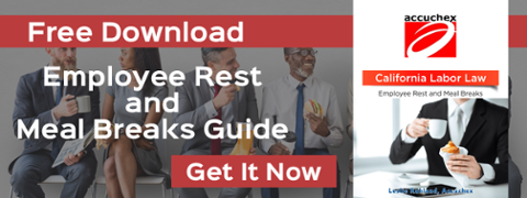Among the myriad of laws, rule and regulations businesses must comply with, meal and rest breaks in California can be some of the more challenging.

Simply managing and complying with the regulatory maze of California labor laws can be difficult for employers and their HR managers. Each year brings new laws and very few "old" ones ever get removed. As a result, this growing body of regulation can make payroll management functions confusing and frustrating for both management and staff.
There are issues such as minimum hours, employee classification, and hiring activities that require research and policy changes in order to ensure proper compliance.
By developing and maintaining processes for regular review of labor laws such California break laws, you can be proactive in updating your compliance procedures for the ever changing California (and federal) labor laws.
Meal and Rest Breaks: California Break Laws
Each year brings new legislation with additional or changed regulations and reporting requirements. The State of California Department of Industrial Relations (DIR) and other agencies work to keep employers apprised of these updates and changes.
Due diligence on the part of the business owners and HR managers can prevent overlooking employer obligations. This is essential as compliance mistakes can lead to costly claims, penalties, and even employee lawsuits.
California rest break law governing employee meal and rest breaks is a frequet example of mismanaged compliance.
California Break Laws: An Overview
Here are some of the more common compliance issues surrounding California rest break law:
Hours Worked
According to the California labor law, "hours worked" means:
“the time during which an employee is subject to the control of an employer, and includes all the time the employee is suffered or permitted to work, whether or not required to do so.”
For calculating actual hours worked the state of California permits “rounding” of employee time to the nearest one-tenth, five minutes, or a quarter hour. However, this method is not allowed if it can result in the failure to properly compensate your employees for the time they have worked.
Employers are allowed to disregard “insignificant periods of time” outside the regular scheduled working hours that cannot be precisely recorded for payroll purposes. These must be only be occasional periods of time that only last a few seconds or minutes, however.
Meal Breaks
Employees in California must be provided with at least 30 minute meal break if they work more than five hours in the day. The meal period must begin before, or at, the end of an employee’s fifth hour of work.
If an employee works more than ten hours in the same day, they are due a second meal period of no fewer than 30 minutes. The second meal break must be provided no later than the end of an employee's tenth hour of work.
Employers are not required to pay for meal periods and employees should clock in and out for meal periods.
In 2012 the California Supreme Court held that meal periods can be taken early in a shift, even though this can result in an employee working more than five hours after the meal. In addition, the court also made it clear that while employers must provide meal breaks, they don't have to require employees to use those breaks.
Employers must relieve employees of all duties during meal breaks and cannot regulate their activities and they cannot “impede or discourage” employees from taking a meal break. They must also allow employees a “reasonable opportunity” to take an uninterrupted 30-minute break. but are not required to prevent work from being done during those breaks.
In some limited situations meal periods may be waived:
- If the employee will work no more than six hours total in the day, and the employee and employer agree to waive the meal period; and
- If the employee works between 10 and 12 hours, the second meal period may be waived if the first meal period was not waived.
Rest Breaks
California rest break law requires employers to “authorize and permit” employees to take one 10-minute rest period for each four-hour work period, or “major fraction thereof", which is anything more than two hours.
However, a rest break is not required for employees whose total daily work time is less than three and one-half hours. Although no specific timing is required, the rest breaks should be taken, to the extent that it is reasonable, in the middle of each work period.
Rest breaks in California must be provided as follows:

Typically, if an employee works an eight-hour shift, one rest break should be taken before the meal break, and one after. Because rest breaks count as time worked employees must be paid for this time. If the employer does not allow an employee to take a rest period, the employee is entitled to one hour of pay at the employee’s regular rate of pay for each workday that rest periods are not made available.
This also applies to recovery periods, or cool down periods, that are allowed for employees to prevent heat illness under other state laws and regulations.
Employers are also required to provide suitable resting facilities such as a break area or kitchen.
Piece-Rate Workers
The California Court of Appeals recently confirmed that non-exempt commissioned employees are entitled to enhanced compensation during rest and recovery periods. Thr ruling means that commissioned employees, such as “piece-rate” employees must be paid for the 10 minute rest breaks required by California law and that these breaks must be separately tracked and compensated at the rates dictated by the statute.
The state Labor Code was updated with Section 226.2 for California employers who pay employees on a piece-rate basis for any part of their work. It requires employers to pay piece-rate employees for rest and recovery periods, and all periods of “other nonproductive time” separately from, and in addition to, their piece-rate pay.
Employers must pay piece-rate employees for rest and recovery periods at an hourly rate determined by dividing the employee’s total compensation for the workweek (excluding compensation for rest and recovery periods and overtime premiums) by the total hours worked during the workweek (not including rest and recovery periods).Meetings, Training and Lectures
California follows the federal law for determining whether employees need to be paid for time spent attending meetings, training and lectures. This means that this time is not counted as “hours worked” if:
- Attendance is outside regular work hours
- Attendance is voluntary
- The course, lecture or meeting is not related directly to the employee’s job training, and
- The employee does not perform any productive work during the training, lecture or meeting
California Break Laws for Agricultural Workers
California has a large agricultural workforce. As a result, there are special provisions in the California labor laws regarding breaks for agricultural and outdoor workers.
Employees engaged in agriculture and outdoor work such as landscaping and farming are entitled to sufficient rest breaks when temperatures exceed 85 degrees. This is defined as a minimum five minutes in the shade, on an “as needed” basis.
This law applies to all employees, including illegal immigrants, according to provisions of the California Labor Code.
If an employee is not given proper meal and rest periods the employer must pay to the employee one hour of pay as a penalty. This includes defined “recovery periods” or “cool down period afforded an employee to prevent heat illness.”
Reporting Time Pay
There are times when employees may report to work, but for certain reasons are not put to work, or are provided with less than half of the usual or scheduled days’ wages. In those situations, employees are entitled to reporting time pay.
This means that employers are required to pay for half of the employee's usual, or scheduled, day’s work. This must not be less than two hours, nor more than four hours, of their normal wages.
In addition, employees who are required to report for work a second time on any one workday and are given less than two hours of work on the second reporting must be paid for at least two hours at their regular rate of pay.
There are exceptions to the requirement for providing reporting time pay:
- Operations cannot continue or commence due to threats to employees or property
- Civil authorities recommend that operations not continue or commence
- There is a failure to public utilities or sewer system
- The interruption is caused by an act of God or other cause not in the control of the employer
Travel Time
California labor law has different rules on travel time than federal requirements. California requires that employees be paid for all hours of work-related travel, regardless of whether those hours are during “normal” working hours, or for longer assignments.
Employers can establish a different rate of pay for travel time, if they choose. However, the California law does not require employers to pay employees for commuting to and from work.
In addition, California employers who require employees to use personal vehicles for work may be liable for employee car accidents during a commute, or even on a personal errand during "normal" work hours.
HR Management and California Labor Law
As a business owner, or HR manager, you have a number of options for your payroll functions. Software that can be installed in-house, or cloud-based programs offer a good alternative.
But if you really want to take full advantage of the benefits available to you, outsourcing to a provider like Accuchex can still be the best decision.
If you are currently looking to invest in outsourcing, download our free resource, the Payroll Outsourcing Guide, to help you make an informed decision.
Or call Accuchex Payroll Management Services at 877-422-2824.
In addition, you can find helpful guidance with our guide by clicking this button:




